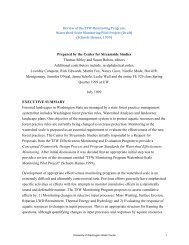Copyright 2012 Aileen M. Echiverri-Cohen - University of Washington
Copyright 2012 Aileen M. Echiverri-Cohen - University of Washington
Copyright 2012 Aileen M. Echiverri-Cohen - University of Washington
Create successful ePaper yourself
Turn your PDF publications into a flip-book with our unique Google optimized e-Paper software.
Roman font, measuring 10 mm wide and 10 mm tall in white text against a black background.<br />
The response keys on the computer keyboard were labeled to aid with identification. All the<br />
stimuli within the RSVP sequence were displayed for 16 ms, followed by a 25-30 ms<br />
interstimulus interval (ISI). Generation <strong>of</strong> the targets and distractors were similar to the paradigm<br />
used by Cheung, Chen, Chen, Woo, and Yee (2002). The distractors in the RSVP sequence were<br />
arranged in a random order, under the constraint that the same distractor cannot appear in the<br />
previous four serial positions in the RSVP sequence. The letters were randomly drawn from the<br />
target set, and designated T1 and T2. No letter could appear more than once in a block <strong>of</strong> four<br />
consecutive sequences, and a distractor always followed T2. The overall task consisted <strong>of</strong> 124<br />
sequences, with two separate versions. The first four sequences were practice trials, and the<br />
remaining 120 sequences were used for data collection.<br />
Prepulse inhibition. To provide a physiological measure <strong>of</strong> inhibition, PPI was used<br />
(Graham, 1979). The startle stimulus consisted <strong>of</strong> a 50 ms burst <strong>of</strong> 105 dB noise with a 0<br />
instantaneous rise/fall time. The prepulses consisted <strong>of</strong> 25 ms, non-startling tones (75 dB, 1000<br />
Hz, 4 ms rise/fall times) at 30 ms, 60 ms, and 120 ms interstimulus intervals before the onset <strong>of</strong><br />
the startle stimulus. These prepulse intervals were used because 30 ms and 60 ms are thought to<br />
reflect automatic processes (Wu et al., 1984; Wynn et al., 1996) and the 120 ms prepulse interval<br />
is thought to reflect more strategic attention (Filion et al., 1993, Hazlett, Dawson, Nuechterlein,<br />
& Filion, 1993; McDowd, Filion, Harris, & Braff, 1993).<br />
Intensity levels <strong>of</strong> the startle probes and non-startling tones were calibrated with a sound<br />
level meter (Digital-display sound-level meter, Model: 33-2055). Stimulus presentation was<br />
controlled using Eprime s<strong>of</strong>tware v 1.0 (Psychology S<strong>of</strong>tware Tools, Inc.) on a 17-inch Dell<br />
monitor. A series <strong>of</strong> startle stimuli trials were presented either alone or preceded by prepulses.<br />
22
















